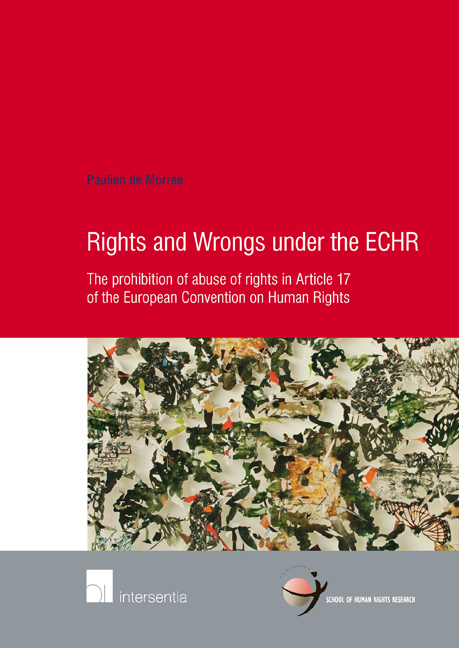 Rights and Wrongs under the ECHR
Rights and Wrongs under the ECHR Published online by Cambridge University Press: 12 December 2017
INTRODUCTION
The prohibition of abuse of rights in Article 17 ECHR is very much a product of its time. Before the second half of the 20th century, such a formula had not been recognised in any of the principal human rights texts. But the historical context in which the Convention came into being – just after the Second World War – was crucial for the creation of the abuse clause. This chapter explores what motivated the drafters to include Article 17 ECHR in the Convention. It will move through the different stages of the drafting of the Convention, from the first steps in creating a European human rights treaty by the European Movement in 1948 to the final signing of the Convention by the Member States of the Council of Europe in 1950. The drafting of the Convention, even though it took only roughly two years, was a complex and arduous process. This chapter will not elaborate at length on this process, but instead focuses on aspects of the drafting of the Convention that form the background of the prohibition of abuse of rights in Article 17 ECHR.
FIRST STEPS BY THE EUROPEAN MOVEMENT
The ECHR was developed during the turbulent first years following the Second World War. On the one hand, the atrocities committed by the Nazi regime had shaken up the international community and through international cooperation European democracies wanted to prevent such a tragedy from ever happening again. On the other hand, the immediate post-war period was dominated by rising tensions between ‘East’ and ‘West’ and the Soviet Union under Stalin was considered a severe and immediate threat to Western European democracies. In the midst of all of this, the first steps towards a European human rights convention were taken by the International Committee of the Movement of European Unity, or the ‘European Movement’.
During the first half of 1949 the European Movement started to prepare a draft European human rights convention. Set against the experience of totalitarianism during the Second World War, they attached great significance to democracy. They believed respect for human rights and a democratic form of government to go hand in hand. The Convention to be drafted would therefore embody Europe's ‘ardent belief in human rights and democracy’.
To save this book to your Kindle, first ensure [email protected] is added to your Approved Personal Document E-mail List under your Personal Document Settings on the Manage Your Content and Devices page of your Amazon account. Then enter the ‘name’ part of your Kindle email address below. Find out more about saving to your Kindle.
Note you can select to save to either the @free.kindle.com or @kindle.com variations. ‘@free.kindle.com’ emails are free but can only be saved to your device when it is connected to wi-fi. ‘@kindle.com’ emails can be delivered even when you are not connected to wi-fi, but note that service fees apply.
Find out more about the Kindle Personal Document Service.
To save content items to your account, please confirm that you agree to abide by our usage policies. If this is the first time you use this feature, you will be asked to authorise Cambridge Core to connect with your account. Find out more about saving content to Dropbox.
To save content items to your account, please confirm that you agree to abide by our usage policies. If this is the first time you use this feature, you will be asked to authorise Cambridge Core to connect with your account. Find out more about saving content to Google Drive.